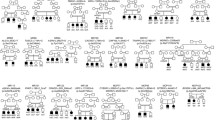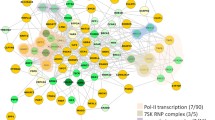Abstract
Mental retardation (MR) has a worldwide prevalence of around 2% and is a frequent cause of severe disability. Significant excess of MR in the progeny of consanguineous matings as well as functional considerations suggest that autosomal recessive forms of MR (ARMR) must be relatively common. To shed more light on the causes of autosomal recessive MR (ARMR), we have set out in 2003 to perform systematic clinical studies and autozygosity mapping in large consanguineous Iranian families with non-syndromic ARMR (NS-ARMR). As previously reported (Najmabadi et al. in Hum Genet 121:43–48, 2007), this led us to the identification of 12 novel ARMR loci, 8 of which had a significant LOD score (OMIM: MRT5–12). In the meantime, we and others have found causative gene defects in two of these intervals. Moreover, as reported here, tripling the size of our cohort has enabled us to identify 27 additional unrelated families with NS-ARMR and single-linkage intervals; 14 of these define novel loci for non-syndromic ARMR. Altogether, 13 out of 39 single linkage intervals observed in our cohort were found to cluster at 6 different loci on chromosomes, i.e., 1p34, 4q27, 5p15, 9q34, 11p11–q13 and 19q13, respectively. Five of these clusters consist of two significantly overlapping linkage intervals, and on chr 1p34, three single linkage intervals coincide, including the previously described MRT12 locus. The probability for this distribution to be due to chance is only 1.14 × 10−5, as shown by Monte Carlo simulation. Thus, in contrast to our previous conclusions, these novel data indicate that common molecular causes of NS-ARMR do exist, and in the Iranian population, the most frequent ones may well account for several percent of the patients. These findings will be instrumental in the identification of the underlying genes.

Similar content being viewed by others
References
Abbasi Moheb L, Jensen LR, Garshasbi M, Kahrizi K, Ghadami S, Wrogemann K, Hu H, Kariminejad R, Behjati F, Mohseni M, Falah M, Khodai H, Kasiri M, Darvish H, Tzschach A, Ropers HH, Najmabadi H, Kuss AW (2009) Two independent mutations in the ZNF526 gene are associated with non-syndromic autosomal recessive mental retardation. In: Annual meeting of the American Society for Human Genetics, Honolulu, Hawaii
Al-Ansari A (1993) Etiology of mild mental retardation among Bahraini children: a community-based case control study. Ment Retard 31:140–143
Basel-Vanagaite L, Attia R, Yahav M, Ferland RJ, Anteki L, Walsh CA, Olender T, Straussberg R, Magal N, Taub E, Drasinover V, Alkelai A, Bercovich D, Rechavi G, Simon AJ, Shohat M (2006) The CC2D1A, a member of a new gene family with C2 domains, is involved in autosomal recessive non-syndromic mental retardation. J Med Genet 43:203–210
Bittles A (2001) Consanguinity and its relevance to clinical genetics. Clin Genet 60:89–98
Bittles AH, Neel JV (1994) The costs of human inbreeding and their implications for variations at the DNA level. Nat Genet 8:117–121
Bundey S, Alam H, Kaur A, Mir S, Lancashire R (1991) Why do UK-born Pakistani babies have high perinatal and neonatal mortality rates? Paediatr Perinat Epidemiol 5:101–114
Chiurazzi P, Schwartz CE, Gecz J, Neri G (2008) XLMR genes: update 2007. Eur J Hum Genet 16:422–434
Durkin MS, Hasan ZM, Hasan KZ (1998) Prevalence and correlates of mental retardation among children in Karachi, Pakistan. Am J Epidemiol 147:281–288
Erdogan F, Chen W, Kirchhoff M, Kalscheuer VM, Hultschig C, Muller I, Schulz R, Menzel C, Bryndorf T, Ropers HH, Ullmann R (2006) Impact of low copy repeats on the generation of balanced and unbalanced chromosomal aberrations in mental retardation. Cytogenet Genome Res 115:247
Fernell E (1998) Aetiological factors and prevalence of severe mental retardation in children in a Swedish municipality: the possible role of consanguinity. Dev Med Child Neurol 40:608–611
Garshasbi M, Motazacker MM, Kahrizi K, Behjati F, Abedini SS, Nieh SE, Firouzabadi SG, Becker C, Ruschendorf F, Nurnberg P, Tzschach A, Vazifehmand R, Erdogan F, Ullmann R, Lenzner S, Kuss AW, Ropers HH, Najmabadi H (2006) SNP array-based homozygosity mapping reveals MCPH1 deletion in family with autosomal recessive mental retardation and mild microcephaly. Hum Genet 118:708–715
Garshasbi M, Hadavi V, Habibi H, Kahrizi K, Kariminejad R, Behjati F, Tzschach A, Najmabadi H, Ropers HH, Kuss AW (2008) A defect in the TUSC3 gene is associated with autosomal recessive mental retardation. Am J Hum Genet 82:1158–1164
Higgins JJ, Pucilowska J, Lombardi RQ, Rooney JP (2004) A mutation in a novel ATP-dependent on protease gene in a kindred with mild mental retardation. Neurology 63:1927–1931
Inlow JK, Restifo LL (2004) Molecular and comparative genetics of mental retardation. Genetics 166:835–881
Kulkarni ML, Kurian M (1990) Consanguinity and its effect on fetal growth and development: a south Indian study. J Med Genet 27:348–352
Kuss AW, Hu H, Garshasbi M, Bahman I, Ghadami S, Motazacker MM, Abbasi-Moheb L, Esmaeeli-Nieh S, Puettmann L, M. M, Soltani Banavandi J, Darvish H, Jamali P, Nikoui P, Soleimani F, Kahrizi K, Tzschach A, Chen W, Ropers HH, Najmabadi H (2010) Deep sequencing leads to the identification of 3 independent mutations in the ST3GAL3 gene in patients with autosomal recessive intellectual disability from 3 consanguineous Iranian families. In: European Human Genetics Conference 2010, Gothenburg, Sweden
Mir A, Kaufman L, Noor A, Motazacker MM, Jamil T, Azam M, Kahrizi K, Rafiq MA, Weksberg R, Nasr T, Naeem F, Tzschach A, Kuss AW, Ishak GE, Doherty D, Ropers HH, Barkovich AJ, Najmabadi H, Ayub M, Vincent JB (2009) Identification of mutations in TRAPPC9, which encodes the NIK- and IKK-beta-binding protein, in nonsyndromic autosomal-recessive mental retardation. Am J Hum Genet 85:909–915
Mochida GH, Mahajnah M, Hill AD, Basel-Vanagaite L, Gleason D, Hill RS, Bodell A, Crosier M, Straussberg R, Walsh CA (2009) A truncating mutation of TRAPPC9 is associated with autosomal-recessive intellectual disability and postnatal microcephaly. Am J Hum Genet 85:897–902
Molinari F, Rio M, Meskenaite V, Encha-Razavi F, Auge J, Bacq D, Briault S, Vekemans M, Munnich A, Attie-Bitach T, Sonderegger P, Colleaux L (2002) Truncating neurotrypsin mutation in autosomal recessive nonsyndromic mental retardation. Science 298:1779–1781
Molinari F, Foulquier F, Tarpey PS, Morelle W, Boissel S, Teague J, Edkins S, Futreal PA, Stratton MR, Turner G, Matthijs G, Gecz J, Munnich A, Colleaux L (2008) Oligosaccharyltransferase-subunit mutations in nonsyndromic mental retardation. Am J Hum Genet 82:1150–1157
Motazacker MM, Rost BR, Hucho T, Garshasbi M, Kahrizi K, Ullmann R, Abedini SS, Nieh SE, Amini SH, Goswami C, Tzschach A, Jensen LR, Schmitz D, Ropers HH, Najmabadi H, Kuss AW (2007) A defect in the ionotropic glutamate receptor 6 gene (GRIK2) is associated with autosomal recessive mental retardation. Am J Hum Genet 81:792–798
Najmabadi H, Motazacker MM, Garshasbi M, Kahrizi K, Tzschach A, Chen W, Behjati F, Hadavi V, Nieh SE, Abedini SS, Vazifehmand R, Firouzabadi SG, Jamali P, Falah M, Seifati SM, Gruters A, Lenzner S, Jensen LR, Ruschendorf F, Kuss AW, Ropers HH (2007) Homozygosity mapping in consanguineous families reveals extreme heterogeneity of non-syndromic autosomal recessive mental retardation and identifies 8 novel gene loci. Hum Genet 121:43–48
Najmabadi H, Garshasbi M, Bahman I, Ghadami S, Motazacker MM, Abbasi-Moheb L, Puettmann L, Wrogemann K, Behjati F, Kariminejad R, Mohseni M, Soltani Banavandi MJ, Dravish H, Jamali P, Heshmati Y, Nikuei P, Soleimani F, Hu H, Chen W, Kahrizi K, Tzschach A, Kuss AW, Ropers HH (2009) Homozygosity mapping in 4 unrelated Iranian families with autosomal recessive mental retardation identifies overlapping linkage intervals on chromosome 1p34: a frequent cause of ARMR? 14th international Workshop on Fragile X and X-Linked Mental Retardation, Bahia, Brazil
Philippe O, Rio M, Carioux A, Plaza JM, Guigue P, Molinari F, Boddaert N, Bole-Feysot C, Nitschke P, Smahi A, Munnich A, Colleaux L (2009) Combination of linkage mapping and microarray-expression analysis identifies NF-kappaB signaling defect as a cause of autosomal-recessive mental retardation. Am J Hum Genet 85:903–908
Rabionet R, Gasparini P, Estivill X (2000) Molecular genetics of hearing impairment due to mutations in gap junction genes encoding beta connexins. Hum Mutat 16:190–202
Rafiq MA, Ansar M, Marshall CR, Noor A, Shaheen N, Mowjoodi A, Khan MA, Ali G, Amin-Ud-Din M, Feuk L, Vincent JB, Scherer SW (2010) Mapping of three novel loci for non-syndromic autosomal recessive mental retardation (NS-ARMR) in consanguineous families from Pakistan. Clin Genet 78:478–483
Ropers HH (2006) X-linked mental retardation: many genes for a complex disorder. Curr Opin Genet Dev 16:260–269
Ropers HH (2008) Genetics of intellectual disability. Curr Opin Genet Dev 18:241–250
Ropers HH (2010) Genetics of early-onset cognitive impairment. Annu Rev Genomics Hum Genet 11:161–187
Ropers HH, Hamel BC (2005) X-linked mental retardation. Nat Rev Genet 6:46–57
Temtamy SA, Kandil MR, Demerdash AM, Hassan WA, Meguid NA, Afifi HH (1994) An epidemiological/genetic study of mental subnormality in Assiut Governorate, Egypt. Clin Genet 46:347–351
Uyguner O, Kayserili H, Li Y, Karaman B, Nurnberg G, Hennies H, Becker C, Nurnberg P, Basaran S, Apak MY, Wollnik B (2007) A new locus for autosomal recessive non-syndromic mental retardation maps to 1p21.1–p13.3. Clin Genet 71:212–219
Yaqoob M, Bashir A, Tareen K, Gustavson KH, Nazir R, Jalil F, von Dobeln U, Ferngren H (1995) Severe mental retardation in 2 to 24-month-old children in Lahore, Pakistan: a prospective cohort study. Acta Paediatr 84:267–272
Acknowledgments
We are grateful to all affected individuals and their families for their participation in the study. We would like to have special thanks to Dr. Shahrbanoo Nakhai, the head of USWR for financial support. This work was supported by the Max Planck Innovation Fund and a grant form the German Federal Ministry of Education and Research to H.H.R. (MRNET 01GS08161-2) and D.W. (MRNET 01GS08167). H.N., H.H.R., A.W.K., K.K. and A.T. are members of the GENCODYS consortium. This work was also supported financially by a grant from the Iranian National Science Foundation.
Author information
Authors and Affiliations
Corresponding authors
Additional information
A. W. Kuss, M. Garshasbi contributed equally.
Electronic supplementary material
Below is the link to the electronic supplementary material.
Rights and permissions
About this article
Cite this article
Kuss, A.W., Garshasbi, M., Kahrizi, K. et al. Autosomal recessive mental retardation: homozygosity mapping identifies 27 single linkage intervals, at least 14 novel loci and several mutation hotspots. Hum Genet 129, 141–148 (2011). https://doi.org/10.1007/s00439-010-0907-3
Received:
Accepted:
Published:
Issue Date:
DOI: https://doi.org/10.1007/s00439-010-0907-3




